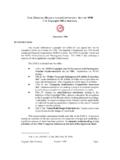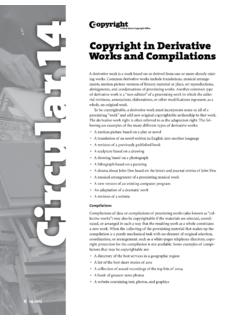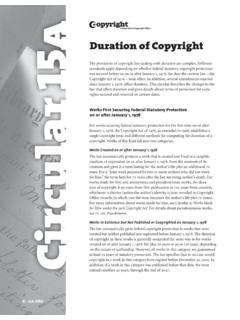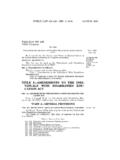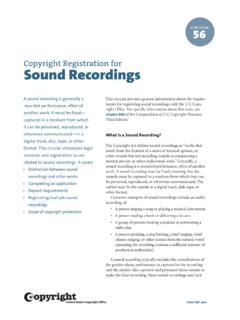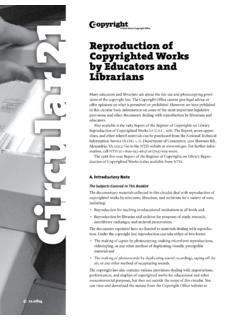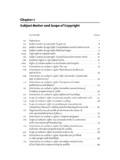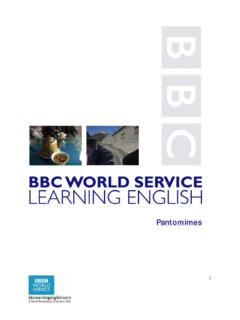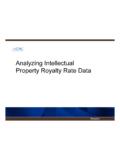Transcription of Circular 1 Copyright Basics
1 1 Copyright is a form of protection provided by the laws of the United States to the authors of original works of authorship that are fixed in a tangible form of expression. An original work of authorship is a work that is independently created by a human author and possesses at least some minimal degree of creativity. A work is fixed when it is captured (either by or under the authority of an author) in a sufficiently permanent medium such that the work can be perceived, reproduced, or communicated for more than a short time. Copyright protection in the United States exists automatically from the moment the original work of authorship is Works Are Protected?Examples of copyrightable works include Literary works Musical works, including any accompanying words Dramatic works, including any accompanying music Pantomimes and choreographic works Pictorial, graphic, and sculptural works Motion pictures and other audiovisual works Sound recordings, which are works that result from the fixation of a series of musical, spoken, or other sounds Architectural worksThese categories should be viewed broadly for the purpose of registering your work.
2 For example, computer programs and certain compilations can be registered as literary works ; maps and technical drawings can be registered as pictorial, graphic, and sculptural works. Copyright is a form of protection provided by law to authors of original works of authorship from the time the works are created in a fixed form. This Circular provides an overview of basic facts about Copyright and Copyright registration with the Copyright Office. It covers Works eligible for protection Rights of Copyright owners Who can claim Copyright Duration of copyrightCopyright BasicsCopyright Basics2note: Before 1978, federal Copyright was generally secured by publishing a work with an appro-priate Copyright notice. works that were in the public domain on January 1, 1978, when the 1976 Copyright Act took effect, remain in the public domain under the 1976 Are the Rights of a Copyright Owner?
3 Copyright provides the owner of Copyright with the exclusive right to Reproduce the work in copies or phonorecords2 Prepare derivative works based upon the work Distribute copies or phonorecords of the work to the public by sale or other transfer of owner-ship or by rental, lease, or lending Perform the work publicly if it is a literary, musical, dramatic, or choreographic work; a panto-mime; or a motion picture or other audiovisual work Display the work publicly if it is a literary, musical, dramatic, or choreographic work; a pan-tomime; or a pictorial, graphic, or sculptural work. This right also applies to the individual images of a motion picture or other audiovisual work. Perform the work publicly by means of a digital audio transmission if the work is a sound recordingCopyright also provides the owner of Copyright the right to authorize others to exercise these exclusive rights, subject to certain statutory Is Not Protected by Copyright ?
4 Copyright does not protect Ideas, procedures, methods, systems, processes, concepts, principles, or discoveries Works that are not fixed in a tangible form (such as a choreographic work that has not been notated or recorded or an improvisational speech that has not been written down) Titles, names, short phrases, and slogans Familiar symbols or designs Mere variations of typographic ornamentation, lettering, or coloring Mere listings of ingredients or contentsFor more information, see Works Not Protected by Copyright ( Circular 33).Who Can Claim Copyright ?The Copyright in a work initially belongs to the author(s) who created that work. When two or more authors create a single work with the intent of merging their contributions into inseparable or inter-dependent parts of a unitary whole, the authors are considered joint authors and have an indivisible interest in the work as a whole.
5 By contrast, if multiple authors contribute to a collective work, each Copyright Basics3author s individual contribution is separate and distinct from the Copyright ownership in the collec-tive work as a whole. Works made for hire are an important exception to the general rule for claiming Copyright . When a work is made for hire, the author is not the individual who actually created the work. Instead, the party that hired the individual is considered the author and the Copyright owner of the work. Whether a work is made for hire is determined by the facts that exist at the time the work is created. There are two situations in which a work may be made for hire:1. When the work is created by an employee as part of the employee s regular duties, or2. When an individual and the hiring party enter into an express written agreement that the work is to be considered a work made for hire and the work is specially ordered or commis-sioned for use as: A compilation A contribution to a collective work A part of a motion picture or other audiovisual work A translation A supplementary work An instructional text A test Answer material for a test An atlasThe concept of work made for hire can be complicated and has serious consequences for both the individual who creates the work and the hiring party who is considered to be the author and copy-right owner of the work.
6 For more information, see Works Made for Hire ( Circular 30).note: Mere ownership of a copy or phonorecord that embodies a work does not give the owner of that copy or phonorecord the ownership of the Copyright in the of Copyright OwnershipAny or all of the Copyright owner s exclusive rights, or parts of those rights, can be transferred. The transfer, however, generally must be made in writing and signed by the owner of the rights conveyed or the owner s authorized agent. Transferring a right on a nonexclusive basis does not require a writ-ten can bequeath a Copyright by will or pass it along as personal property under applicable state laws of intestate succession. It can also be conveyed by operation of can record a transfer of Copyright ownership with the Copyright Office through its Office of Public Records and Repositories.
7 Although recordation is not required to make a valid transfer between parties, it does provide certain legal advantages. For more information, see Recordation of Transfers and Other Documents ( Circular 12). Copyright Basics4 Termination of a Copyright TransferUnder certain circumstances, the Copyright Act allows authors or their heirs to terminate an agree-ment that transferred or licensed the author s Copyright to a third party after thirty-five years. To terminate a grant, the author or the author s heirs must serve an advance written notice of termi-nation on the grantee or the grantee s successor-in-interest and must record a copy of that notice with the Copyright Office and pay the required filing notice of termination must be recorded before the effective date of termination specified in the notice.
8 If a notice of termination is not recorded in a timely manner, the notice will be invalid, and the author or the author s heirs will not be able to terminate the agreement. For more information, see chapter 2300, section 2310 of the Compendium of Copyright Office Long Does Copyright Last?In general, for works created on or after January 1, 1978, the term of Copyright is the life of the author plus seventy years after the author s death. If the work is a joint work with multiple authors, the term lasts for seventy years after the last surviving author s death. For works made for hire and anonymous or pseudonymous works, the duration of Copyright is 95 years from publication or 120 years from creation, whichever is works created before January 1, 1978, that were not published or registered as of that date, the term of Copyright is generally the same as for works created on or after January 1, 1978.
9 The law, however, provides that in no case would the term have expired before December 31, 2002, and if the work was published on or before that date, the term will not expire before December 31, works created before January 1, 1978, that were published or registered before that date, the initial term of Copyright was twenty-eight years from the date of publication with notice or from the date of registration. At the end of the initial term, the Copyright could be renewed for another sixty-seven years for a total term of protection of up to ninety-five years. To extend Copyright into the renewal term, two registrations had to be made before the original term expired: one for the original term and the other for the renewal term. This requirement was eliminated on June 26, 1992, and renewal term registration is now more information on the term of Copyright protection, see Duration of Copyright ( Circular 6) and Renewal of Copyright ( Circular 6A).
10 How Can I Protect My Work? Copyright exists automatically in an original work of authorship once it is fixed in a tangible medium, but a Copyright owner can take steps to enhance the protections of Copyright , the most important of which is registering the work. Although registering a work is not mandatory, for works of origin, registration (or refusal) is necessary to enforce the exclusive rights of Copyright through a Copyright notice to a work has not been required since March 1, 1989, but may still provide practical and legal benefits. Notice typically consists of the Copyright symbol or the word Copyright , the name of the Copyright owner, and the year of first publication. Placing a Copyright notice on a work is not a substitute for Basics5 Benefits of RegistrationRegistration establishes a claim to Copyright with the Copyright Office.
